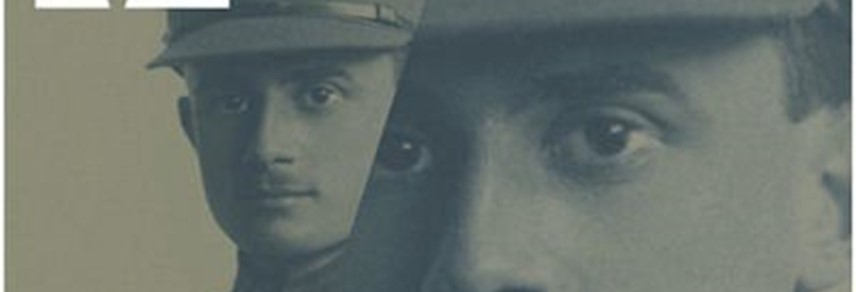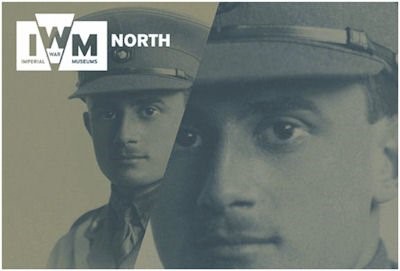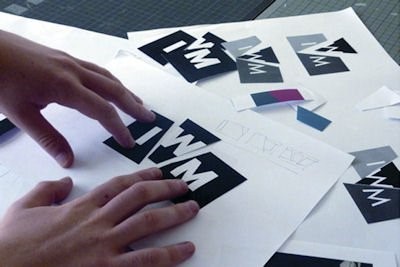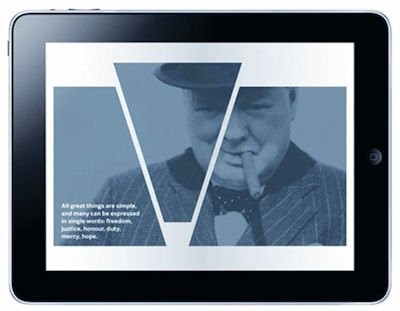
MONDAY 16 JAN 2012 12:00 AM
ON THE FRONTLINES
IWM, formerly Imperial War Museums, tells the story of how British lives have been affected by war since the early 20th century. Molly Pierce reports on how its rebrand brings IWM firmly into the 21st
 In 1917, Britain was in the midst of a war that had had a devastating effect on the nation. The MP Sir Alfred Mond suggested to Lloyd George that a National War Museum be established to record the experiences of everyone involved in the war, both civilian and military, and to mark the sacrifices made in the war effort.
In 1917, Britain was in the midst of a war that had had a devastating effect on the nation. The MP Sir Alfred Mond suggested to Lloyd George that a National War Museum be established to record the experiences of everyone involved in the war, both civilian and military, and to mark the sacrifices made in the war effort.94 years later, and the National War Museum has become the Imperial War Museums, with five sites across England – as well as IWM London, there is the largest aviation museum in the UK at IWM Duxford, HMS Belfast, a preserved cruiser which served in WWII, the Churchill War Rooms, and IWM North in Manchester.
The spread of the Imperial War Museums brand over these sites, however, had diluted any sort of consistent messaging from the museum. “There was
a lack of awareness in public that all five museums were part of the same organisation,” says head of brand and marketing Penny Hamilton, who was recruited by director-general Diane Lees in May 2010 to review the brand.
“We wanted to make sure that the museum brand was fit for the future. It needed to be an audience-focused brand, so we started with a research programme, running staff workshops, exit surveys, online questioning, and key stakeholder interviews,” says Hamilton. “We started getting the big picture – of what we were and where we wanted to be.”
IWM had by that point tendered out the strategy for the rebrand. Jane Wentworth, director at Jane Wentworth Associates, took on the task. “My association with IWM went back a very long way. Over the last seven or eight years I’d been popping in and out, talking to different personnel, saying ‘Are you ready yet?’” Wentworth had also known Lees and Hamilton through previous projects. “Then, suddenly, we’d started. I suppose it’s a lesson to keep in touch with people!”
Wentworth’s team started to collaborate with IWM on research into the existing brand. “The main issue that came out of the research was that the brand was viewed as old-fashioned by its stakeholders,” says Hamilton. “There was a real lack of understanding about the vision behind the museums: people thought that they were military museums, rather than being about social history. The focus of the collections is on the impact of war on people’s lives, and this wasn’t coming across.”
“Actually, the main problem was that it was just the worst possible name you could have,” says Wentworth. “‘Imperial’ sounds old-fashioned, ‘War’ forbidding. It didn’t provoke a fantastic response. But we actually dealt with that pretty quickly, by developing the abbreviation as the centre of the new brand. So it wasn’t such a big problem, really.”
The new brand brings together the five sites under the IWM banner, with each museum’s individual personalities being positioned within the collective. A new strategy has been devised to create awareness of what the collections actually cover. “The museums are about enriching public understanding of the causes, courses, and consequences of war and conflict,” says Hamilton – and communicating this is the biggest challenge the rebrand faces.
Workshops with staff were a jumping-off point for devising IWM’s strategy for the future. The vision that came out of this research was of a collective of museums that isn’t celebratory of war, or militarily jingoistic, but that records what happens in society during times of conflict.
“IWM creates experience through stories, not just objects. We want to engage visitors of all ages through the stories that the collections tell.” Wentworth also points out that it’s a serious historical institution, with archives that are regularly drawn upon by film-makers and academics in search of compelling materials.
A steering group, comprising branch directors, heads of collections and marketing, and Wentworth’s team, also worked up the core values behind the brand. “The big idea that we arrived at was ‘The Force of War’,” says Wentworth, “because it conveys that war is both destructive and creative – it brings about resourceful and imaginative thinking. That messaging was, crucially, flexible for IWM’s various audiences, but allows the organisation to tell its different stories in the same way.”
Working on a museum’s brand presents a different set of problems to rebranding a corporate organisation, as Hamilton recalls. “IWM has a Board of Trustees, to whom we initially presented the results of our research, and who then approved the overall review of the brand. We then presented the new brand blueprint to them which laid out the core vision, values, and positioning of the museums. The Board was extremely supportive of the blueprint, and it was approved at the end of 2010.”

One recommendation in the blueprint was that a new visual identity was needed to accompany the refurbished brand. The creative agency Hat Trick, which had worked on the rebrand of the Natural History Museum in 2004 with Penny Hamilton, won the contract at the end of 2010, and creative director Gareth Howat says that the agency’s experience of the cultural sector and its particular demands helped them get through the selection process.
It was to be a tight turnaround, with sign-off on the creative work by the spring of 2011 in order to get implementation under way for the opening of the Shaped by War: Photographs of Don McCullin in October. Howat says Hat Trick took Wentworth’s “big idea” of ‘The Force of War’ as the starting point for the visual identity.
“There was a really clear brief on where the museum wanted to be and how it was positioning itself. IWM is the new shorthand for the brand, and it needed a very simple, powerful mark. So we started with a block, and literally cut out of it to create a sort of fragmented jigsaw.” The colour palette that Hat Trick developed moved away from the muddy greens and blues of the previous imagery. “It was all rather staid,” says Howat. “We brought in core colours to modernise the look of the brand, as the old imagery
was limited in terms of its application. It’s now a fresher, more flexible look, revolving around three palettes: dark, medium and bright.”
“There was unanimous assent from the steering group when Hat Trick presented its ideas,” recalls Hamilton. “And when the trustees signed it off, it actually got a round of applause.” In working up the rest of the visual identity, Hat Trick was able to draw on IWM’s unrivalled archives of modern and historical images, from which selected core photography is now used in brand collateral.
The shattered look of the new mark was actually inspired by the most recently established branch of the IWM museums, IWM North, which overlooks the Manchester Ship Canal in Trafford Park, an important industrial centre in WWII and the target of heavy bombing during the Manchester Blitz. “We were definitely inspired by Libeskind’s design for IWM North,” says Howat. “It’s composed of three interlocking shards, which represent fragments of a world blown apart by conflict, and it’s an incredibly impressive statement of the force of war. We were actually inspired by all the sites – Duxford is a working airfield, HMS Belfast one of the few surviving warships, the London sites are an ex-hospital and a command centre from WWII – there’s a connection to physical things and places throughout. It was an opportunity to bring all those diverse evocations together.”
“I really like that Hat Trick are creative, but they think strategically,” says Wentworth. “It mirrors the approach that we had to the project. The brief for the design of the new brand was about making it look fresh, contemporary, empathetic, all about personal experience – so the new images focus around people, not guns. It’s a promise that the museum’s collections aren’t jingoistic, but that they focus around the same thing.”
The roll-out of the new brand is, due to IWM’s charity status, a lengthy process. Hat Trick developed brand guidelines that are designed to ensure comms materials across the organisation tie into the umbrella IWM strategy, and a new website has been launched under those guidelines.
“We wanted to start implementing the new brand when we had developed a critical mass of materials,” says Hamilton. “So it was a case of making sure certain things were in place for October and the launch of the McCullin exhibition, and then taking the roll-out on from there. It has to be implemented on as cost-efficient a basis as possible, across the branches, but as London is the flagship property we were able to make a splash. The old brand is still in place at certain points – it’s literally woven into the carpets – but the new identity is gradually taking hold.”
The implementation will carry on over the next two years, leading up to the centenary of the start of WWI in 2014. “Although it’s three years before IWM’s own centenary, it feels very important to acknowledge 1914,” says Hamilton. “We’ll be holding a programme of events across the country, so the brand will be fully embedded by then and fit for purpose.”
“The integration process is slow but sure,” says Howat, and Wentworth concurs: “It would be lovely to flood out the new brand. but there are clear priorities in place. The rebrand is particularly important for staff engagement, as it’s provided a common language across the organisation.
“The best part is that it demonstrates the relevance of the collections. Visitors to IWM – perhaps people whose grandfathers fought in WWII, or who have sons or brothers in the armed forces now – come away saying: ‘Now I understand’.”
 Peer reviews
Peer reviewsNeil Hooper, RPM
The use of striking photography instantly modernises the brand, bringing to life historical events through unparalleled access to visual content. The diagonals which cut through the collateral evoke the fragmentation and violence of war, whilst creatingfurther intrigue towards the images they partly hide. This ‘revealing’ effect cleverly emphasises the museum’s educational drive. The rebrand gives IWM a very design-based look and feel, broadening its appeal to a younger range of consumers who may not necessarily pick an IWM site as a weekend destination. In the same way that the V&A or the Natural History Museum are attracting huge footfall via their modern communication style, the IWM will become a place of intrigue and cultural significance.
Paul Middlebrook, The Allotment Brand Design
It sounds like Hat Trick had an excellent and incisive brief, and this is a credit to the strategic team: clarity is an imperative for fantastic creative work. I love thethe jigsaw approach, which maintains a subtle link to the past. The introduction of multiple colours, the bold use of rich and emotive imagery, and playful, graphic shapes will help broaden the brand’s appeal and ensure that it stays fresh. I hope that this identity serves IWM as well as its last: it was a beautiful example of a simple idea that captured all the fear and foreboding of the blitz, but it was time for a change. The new identity will help to reflect the social history of more modern times and conflicts.
SIMILAR ARTICLES
THUR 26 Sep 2019 3:37 PM
Committing to change
THUR 21 Mar 2019 2:04 PM
Engineering the future
THUR 18 Oct 2018 3:48 PM
Passion play
THUR 9 Jul 2018 10:42 AM
From the annals of architecture



